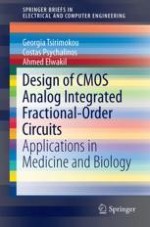This book describes the design and realization of analog fractional-order circuits, which are suitable for on-chip implementation, capable of low-voltage operation and electronic adjustment of their characteristics. The authors provide a brief introduction to fractional-order calculus, followed by design issues for fractional-order circuits of various orders and types. The benefits of this approach are demonstrated with current-mode and voltage-mode filter designs. Electronically tunable emulators of fractional-order capacitors and inductors are presented, where the behavior of the corresponding chips fabricated using the AMS 0.35um CMOS process has been experimentally verified. Applications of fractional-order circuits are demonstrated, including a pre-processing stage suitable for the implementation of the Pan-Tompkins algorithm for detecting the QRS complexes of an electrocardiogram (ECG), a fully tunable implementation of the Cole-Cole model used for the modeling of biological tissues, and a simple, non-impedance based measuring technique for super-capacitors.
